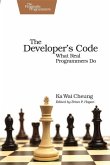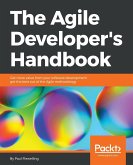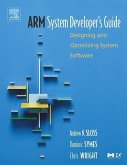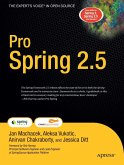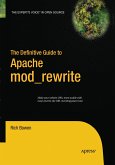The revision of the best-selling Eclipse book on the market, completely revised for Eclipse 3.0!
Loaded with examples and exercises that reinforce knowledge and support self-paced learning
Author team has extensive Eclipse training experience and provides proven learning tips and techniques
Over 18M downloads of Eclipse so far
Eclipse is an open source integration platform that contains a Java development programming environment. In other words, it can work seamlessly with other application development tools you need to use to get your job done. This in-depth and comprehensive book follows and supports the Eclipse user's learning curve. This book begins with the ins-and-outs of Eclipse and teaches the reader how to become a power user and use the flexibility of Eclipse to maximize their productivity. This comprehensive reference is also very practical and shows readers how to build their own plugins and create their own user interfaces. Like the first edition, this revision includes extensive exercises that reinforce all of the concepts from the book. This edition is updated to reflect all major changes in Eclipse 3.0 which include major changes to the APIs, plug-ins, the UI, widgets, JDT (Java development tools) and the ability to be used as a rich-client plaform. The authors' extensive experience with training and teaching Eclipse to vendors makes this title a must-have for any Java developer learning Eclipse. Product Description
"Fully updated and revised for Eclipse 3.0, this book is the definitive Eclipse reference-an indispensable guide for tool builders, rich client application developers, and anyone customizing or extending the Eclipse environment."
-Dave Thomson, Eclipse Project Program Director, IBM The Ultimate Guide to Eclipse 3.0 for the Java Developer. No Eclipse Experience Required! Eclipse is a world-class Java integrated development environment (IDE) and an open source project and community. Written by members of the IBM Eclipse Jumpstart team, The JavaT Developer's Guide to Eclipse, Second Edition, is the definitive Eclipse companion. As in the best-selling first edition, the authors draw on their considerable experience teaching Eclipse and mentoring developers to provide guidance on how to customize Eclipse for increased productivity and efficiency.
In this greatly expanded edition, readers will find
A total update, including the first edition's hallmark, proven exercises-all revised to reflect Eclipse 3.0 changes to the APIs, plug-ins, UI, widgets, and more
A special focus on rich client support with a new chapter and two exercises
A comprehensive exercise on using Eclipse to develop a Web commerce application using Apache's Tomcat
A new chapter on JFace viewers and added coverage of views
A new chapter on internationalization and accessibility
New chapters on performance tuning and Swing interoperability
Using this book, those new to Eclipse will become proficient with it, while advanced developers will learn how to extend Eclipse and build their own Eclipse-based tools. The accompanying CD-ROM contains Eclipse 3.0, as well as exercise solutions and many code examples.
Whether you want to use Eclipse and Eclipse-based offerings as your integrated development environment or customize Eclipse further, this must-have book will quickly bring you up to speed.
Features + Benefits
The revision of the best-selling Eclipse book on the market, completely revised for Eclipse 3.0!
° Loaded with examples and exercises that reinforce knowledge and support selfpaced learning
° Author team has extensive Eclipse training experience and provides proven learning tips and techniques
° Over 18M downloads of Eclipse so far
Backcover
"Fully updated and revised for Eclipse 3.0, this book is the definitive Eclipse reference-an indispensable guide for tool builders, rich client application developers, and anyone customizing or extending the Eclipse environment."
-Dave Thomson, Eclipse Project Program Director, IBM The Ultimate Guide to Eclipse 3.0 for the Java Developer. No Eclipse Experience Required! Eclipse is a world-class Java integrated development environment (IDE) and an open source project and community. Written by members of the IBM Eclipse Jumpstart team, The JavaT Developer's Guide to Eclipse, Second Edition, is the definitive Eclipse companion. As in the best-selling first edition, the authors draw on their considerable experience teaching Eclipse and mentoring developers to provide guidance on how to customize Eclipse for increased productivity and efficiency.
In this greatly expanded edition, readers will find
A total update, including the first edition's hallmark, proven exercises-all revised to reflect Eclipse 3.0 changes to the APIs, plug-ins, UI, widgets, and more
A special focus on rich client support with a new chapter and two exercises
A comprehensive exercise on using Eclipse to develop a Web commerce application using Apache's Tomcat
A new chapter on JFace viewers and added coverage of views
A new chapter on internationalization and accessibility
New chapters on performance tuning and Swing interoperability
Using this book, those new to Eclipse will become proficient with it, while advanced developers will learn how to extend Eclipse and build their own Eclipse-based tools. The accompanying CD-ROM contains Eclipse 3.0, as well as exercise solutions and many code examples.
Whether you want to use Eclipse and Eclipse-based offerings as your integrated development environment or customize Eclipse further, this must-have book will quickly bring you up to speed.
Foreword.
Preface.
Origin of the Book.
Goals.
Intended Audience and Prerequisites.
How the Book Is Organized.
Coding Conventions.
CD-ROM.
Where to Find Further Information.
Guide to Reading This Book.
Acknowledgments.
About the Authors.
1. Read Me First.
Eclipse as a Host for Application Development Tools.
Beyond Tools: Eclipse as a Host for Client Applications.
What Is Eclipse?
Getting and Installing Eclipse.
Chapter Summary.
References.
I. USING ECLIPSE.
2. Getting Started with Eclipse.
Your First Steps.
Basic Eclipse Use.
Resource Management.
Customizing Eclipse.
Exercise Summary.
Chapter Summary.
Reference.
3. Using Java Development Tools.
Getting Started with JDT.
Writing Java Code.
Working with Java Elements.
Tuning the Performance of the JDT.
More on the JDT Views and Preferences.
Exercise Summary.
Chapter Summary.
Reference.
4. Running and Debugging Java.
Running Java Code.
Debugging.
Remote Debugging.
Exercise Summary.
Chapter Summary.
Reference.
5. Teaming Up with Eclipse.
Eclipse Support for CVS.
General Team Support by Eclipse.
An Overview of CVS for the Novice.
The CVS User Interface in Eclipse.
Special Situations and How to Handle Them.
Additional Features.
Exercise Summary.
Chapter Summary.
References.
6. Managing Your Eclipse Environment.
An Overview of Your Eclipse Installation.
Understanding the Runtime Configuration.
Coordinating Preferences.
Understanding Configuration Management Fundamentals.
Interacting with the Update Manager.
Managing Your Configuration.
Chapter Summary.
Reference.
II. FUNDAMENTALS OF EXTENDING ECLIPSE.
7. Extending Eclipse for Fun and Profit.
Excited About Extending Eclipse? You Should Be!
An Easy and Practical Example.
A Brief Tour of Hello, World.
Asking the Right Question Is More Important Than Knowing the Answer.
Where to Go from Here?
8. Overview of the Eclipse Architecture.
That Was Then, This Is Now.
Architectural Top Priorities: Extensibility and Integration.
Eclipse the IDE Platform and Rich Client Application.
The Eclipse Platform Runtime.
User Interface Frameworks.
Workbench Frameworks.
Chapter Summary.
References.
9. Getting Started: Plug-in Development.
Getting Started with Plug-ins.
Getting Started with Extensions and Extension Points.
Basic Steps of Implementing a Plug-in.
Using the Plug-in Development Environment.
Exercise Summary.
Chapter Summary.
References.
10. Creating Applications Using the Rich Client Platform.
Reasons Applications Are Being Built on the RCP.
Eclipse Architecture, Revisited.
Opportunities for Reuse of Eclipse.
Implementing Your Own Workbench.
Exercise Summary.
Chapter Summary.
References.
11. Creating Extension Points: How Others Can Extend Your Plug-ins.
Relationship Between Extension Points and Extensions.
Viewing the Official List of Enabled Plug-ins, Extensions, and Extension Points.
How to Define Extension Points.
Handling Dynamic Plug-ins.
How to Enable the Schema-Based New Extension Wizard.
Example Summary.
Chapter Summary.
References.
12. Advanced Plug-in Development.
Migrating Your Plug-ins from Eclipse 2.1.
Plug-in Class Loader.
Runtime Discovery and Delayed Loading.
Forcing Early Plug-in Activation.
Plug-in Granularity.
Plug-in Fragments.
Chapter Summary.
References.
13. Defining Features and Products.
Features.
Products.
Exercise Summary.
Chapter Summary.
References.
III. EXTENDING THE ECLIPSE WORKBENCH.
14. The Standard Widget Toolkit: A Lean, Mean Widget Machine.
The Basic Structure of an SWT Application.
Common SWT Widgets.
Responding to Events.
How to Arrange SWT Widgets Using Layout Managers.
Error Handling.
Widgets Have Special Disposal Requirements.
Using Threads to Separate UI and Non-UI Activities.
An Overview of SWT Packages.
SWT Support for Swing.
Eclipse Forms.
Example Summary.
Chapter Summary.
References.
15. JFace Viewers.
Viewer Basics.
Viewer Framework.
Creating the Basic Content Viewer Arrangement.
Controlling the Content Displayed in a Structured Viewer.
Interacting with Viewer Objects.
Using Alternative Viewer Types.
Advanced Workbench Integration Options.
Example Summary.
Chapter Summary.
References.
16. Dialogs and Wizards.
Dialogs-The User Interface Beyond Workbench Parts.
Contributing to the Preferences Dialog.
Contributing to the Properties Dialog.
Contributing Wizards.
Directly Opening a Wizard Dialog for Your Wizard.
Example Summary.
<
Eclipse is an open source integration platform that contains a Java
development programming environment. In other words, it can work
seamlessly with other application development tools you need to use to get
your job done. This in-depth and comprehensive book follows and supports
the Eclipse user's learning curve. This book begins with the ins-and-outs of
Eclipse and teaches the reader how to become a power user and use the
flexibility of Eclipse to maximize their productivity. This comprehensive
reference is also very practical and shows readers how to build their own plugins
and create their own user interfaces. Like the first edition, this revision
includes extensive exercises that reinforce all of the concepts from the book.
This edition is updated to reflect all major changes in Eclipse 3.0 which include
major changes to the APIs, plug-ins, the UI, widgets, JDT (Java development
tools) and the ability to be used as a rich-client plaform. The authors' extensive
experience with training and teaching Eclipse to vendors makes this title a
must-have for any Java developer learning Eclipse.
Loaded with examples and exercises that reinforce knowledge and support self-paced learning
Author team has extensive Eclipse training experience and provides proven learning tips and techniques
Over 18M downloads of Eclipse so far
Eclipse is an open source integration platform that contains a Java development programming environment. In other words, it can work seamlessly with other application development tools you need to use to get your job done. This in-depth and comprehensive book follows and supports the Eclipse user's learning curve. This book begins with the ins-and-outs of Eclipse and teaches the reader how to become a power user and use the flexibility of Eclipse to maximize their productivity. This comprehensive reference is also very practical and shows readers how to build their own plugins and create their own user interfaces. Like the first edition, this revision includes extensive exercises that reinforce all of the concepts from the book. This edition is updated to reflect all major changes in Eclipse 3.0 which include major changes to the APIs, plug-ins, the UI, widgets, JDT (Java development tools) and the ability to be used as a rich-client plaform. The authors' extensive experience with training and teaching Eclipse to vendors makes this title a must-have for any Java developer learning Eclipse. Product Description
"Fully updated and revised for Eclipse 3.0, this book is the definitive Eclipse reference-an indispensable guide for tool builders, rich client application developers, and anyone customizing or extending the Eclipse environment."
-Dave Thomson, Eclipse Project Program Director, IBM The Ultimate Guide to Eclipse 3.0 for the Java Developer. No Eclipse Experience Required! Eclipse is a world-class Java integrated development environment (IDE) and an open source project and community. Written by members of the IBM Eclipse Jumpstart team, The JavaT Developer's Guide to Eclipse, Second Edition, is the definitive Eclipse companion. As in the best-selling first edition, the authors draw on their considerable experience teaching Eclipse and mentoring developers to provide guidance on how to customize Eclipse for increased productivity and efficiency.
In this greatly expanded edition, readers will find
A total update, including the first edition's hallmark, proven exercises-all revised to reflect Eclipse 3.0 changes to the APIs, plug-ins, UI, widgets, and more
A special focus on rich client support with a new chapter and two exercises
A comprehensive exercise on using Eclipse to develop a Web commerce application using Apache's Tomcat
A new chapter on JFace viewers and added coverage of views
A new chapter on internationalization and accessibility
New chapters on performance tuning and Swing interoperability
Using this book, those new to Eclipse will become proficient with it, while advanced developers will learn how to extend Eclipse and build their own Eclipse-based tools. The accompanying CD-ROM contains Eclipse 3.0, as well as exercise solutions and many code examples.
Whether you want to use Eclipse and Eclipse-based offerings as your integrated development environment or customize Eclipse further, this must-have book will quickly bring you up to speed.
Features + Benefits
The revision of the best-selling Eclipse book on the market, completely revised for Eclipse 3.0!
° Loaded with examples and exercises that reinforce knowledge and support selfpaced learning
° Author team has extensive Eclipse training experience and provides proven learning tips and techniques
° Over 18M downloads of Eclipse so far
Backcover
"Fully updated and revised for Eclipse 3.0, this book is the definitive Eclipse reference-an indispensable guide for tool builders, rich client application developers, and anyone customizing or extending the Eclipse environment."
-Dave Thomson, Eclipse Project Program Director, IBM The Ultimate Guide to Eclipse 3.0 for the Java Developer. No Eclipse Experience Required! Eclipse is a world-class Java integrated development environment (IDE) and an open source project and community. Written by members of the IBM Eclipse Jumpstart team, The JavaT Developer's Guide to Eclipse, Second Edition, is the definitive Eclipse companion. As in the best-selling first edition, the authors draw on their considerable experience teaching Eclipse and mentoring developers to provide guidance on how to customize Eclipse for increased productivity and efficiency.
In this greatly expanded edition, readers will find
A total update, including the first edition's hallmark, proven exercises-all revised to reflect Eclipse 3.0 changes to the APIs, plug-ins, UI, widgets, and more
A special focus on rich client support with a new chapter and two exercises
A comprehensive exercise on using Eclipse to develop a Web commerce application using Apache's Tomcat
A new chapter on JFace viewers and added coverage of views
A new chapter on internationalization and accessibility
New chapters on performance tuning and Swing interoperability
Using this book, those new to Eclipse will become proficient with it, while advanced developers will learn how to extend Eclipse and build their own Eclipse-based tools. The accompanying CD-ROM contains Eclipse 3.0, as well as exercise solutions and many code examples.
Whether you want to use Eclipse and Eclipse-based offerings as your integrated development environment or customize Eclipse further, this must-have book will quickly bring you up to speed.
Foreword.
Preface.
Origin of the Book.
Goals.
Intended Audience and Prerequisites.
How the Book Is Organized.
Coding Conventions.
CD-ROM.
Where to Find Further Information.
Guide to Reading This Book.
Acknowledgments.
About the Authors.
1. Read Me First.
Eclipse as a Host for Application Development Tools.
Beyond Tools: Eclipse as a Host for Client Applications.
What Is Eclipse?
Getting and Installing Eclipse.
Chapter Summary.
References.
I. USING ECLIPSE.
2. Getting Started with Eclipse.
Your First Steps.
Basic Eclipse Use.
Resource Management.
Customizing Eclipse.
Exercise Summary.
Chapter Summary.
Reference.
3. Using Java Development Tools.
Getting Started with JDT.
Writing Java Code.
Working with Java Elements.
Tuning the Performance of the JDT.
More on the JDT Views and Preferences.
Exercise Summary.
Chapter Summary.
Reference.
4. Running and Debugging Java.
Running Java Code.
Debugging.
Remote Debugging.
Exercise Summary.
Chapter Summary.
Reference.
5. Teaming Up with Eclipse.
Eclipse Support for CVS.
General Team Support by Eclipse.
An Overview of CVS for the Novice.
The CVS User Interface in Eclipse.
Special Situations and How to Handle Them.
Additional Features.
Exercise Summary.
Chapter Summary.
References.
6. Managing Your Eclipse Environment.
An Overview of Your Eclipse Installation.
Understanding the Runtime Configuration.
Coordinating Preferences.
Understanding Configuration Management Fundamentals.
Interacting with the Update Manager.
Managing Your Configuration.
Chapter Summary.
Reference.
II. FUNDAMENTALS OF EXTENDING ECLIPSE.
7. Extending Eclipse for Fun and Profit.
Excited About Extending Eclipse? You Should Be!
An Easy and Practical Example.
A Brief Tour of Hello, World.
Asking the Right Question Is More Important Than Knowing the Answer.
Where to Go from Here?
8. Overview of the Eclipse Architecture.
That Was Then, This Is Now.
Architectural Top Priorities: Extensibility and Integration.
Eclipse the IDE Platform and Rich Client Application.
The Eclipse Platform Runtime.
User Interface Frameworks.
Workbench Frameworks.
Chapter Summary.
References.
9. Getting Started: Plug-in Development.
Getting Started with Plug-ins.
Getting Started with Extensions and Extension Points.
Basic Steps of Implementing a Plug-in.
Using the Plug-in Development Environment.
Exercise Summary.
Chapter Summary.
References.
10. Creating Applications Using the Rich Client Platform.
Reasons Applications Are Being Built on the RCP.
Eclipse Architecture, Revisited.
Opportunities for Reuse of Eclipse.
Implementing Your Own Workbench.
Exercise Summary.
Chapter Summary.
References.
11. Creating Extension Points: How Others Can Extend Your Plug-ins.
Relationship Between Extension Points and Extensions.
Viewing the Official List of Enabled Plug-ins, Extensions, and Extension Points.
How to Define Extension Points.
Handling Dynamic Plug-ins.
How to Enable the Schema-Based New Extension Wizard.
Example Summary.
Chapter Summary.
References.
12. Advanced Plug-in Development.
Migrating Your Plug-ins from Eclipse 2.1.
Plug-in Class Loader.
Runtime Discovery and Delayed Loading.
Forcing Early Plug-in Activation.
Plug-in Granularity.
Plug-in Fragments.
Chapter Summary.
References.
13. Defining Features and Products.
Features.
Products.
Exercise Summary.
Chapter Summary.
References.
III. EXTENDING THE ECLIPSE WORKBENCH.
14. The Standard Widget Toolkit: A Lean, Mean Widget Machine.
The Basic Structure of an SWT Application.
Common SWT Widgets.
Responding to Events.
How to Arrange SWT Widgets Using Layout Managers.
Error Handling.
Widgets Have Special Disposal Requirements.
Using Threads to Separate UI and Non-UI Activities.
An Overview of SWT Packages.
SWT Support for Swing.
Eclipse Forms.
Example Summary.
Chapter Summary.
References.
15. JFace Viewers.
Viewer Basics.
Viewer Framework.
Creating the Basic Content Viewer Arrangement.
Controlling the Content Displayed in a Structured Viewer.
Interacting with Viewer Objects.
Using Alternative Viewer Types.
Advanced Workbench Integration Options.
Example Summary.
Chapter Summary.
References.
16. Dialogs and Wizards.
Dialogs-The User Interface Beyond Workbench Parts.
Contributing to the Preferences Dialog.
Contributing to the Properties Dialog.
Contributing Wizards.
Directly Opening a Wizard Dialog for Your Wizard.
Example Summary.
<
Eclipse is an open source integration platform that contains a Java
development programming environment. In other words, it can work
seamlessly with other application development tools you need to use to get
your job done. This in-depth and comprehensive book follows and supports
the Eclipse user's learning curve. This book begins with the ins-and-outs of
Eclipse and teaches the reader how to become a power user and use the
flexibility of Eclipse to maximize their productivity. This comprehensive
reference is also very practical and shows readers how to build their own plugins
and create their own user interfaces. Like the first edition, this revision
includes extensive exercises that reinforce all of the concepts from the book.
This edition is updated to reflect all major changes in Eclipse 3.0 which include
major changes to the APIs, plug-ins, the UI, widgets, JDT (Java development
tools) and the ability to be used as a rich-client plaform. The authors' extensive
experience with training and teaching Eclipse to vendors makes this title a
must-have for any Java developer learning Eclipse.

